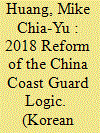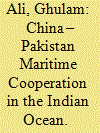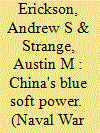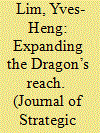|
|
|
Sort Order |
|
|
|
Items / Page
|
|
|
|
|
|
|
| Srl | Item |
| 1 |
ID:
167951


|
|
|
|
|
| Summary/Abstract |
In June 2018, the Chinese government initiated a new round of reforms to reshuffle
the leadership of the China Coast Guard (CCG) so as to better administer the
country’s blue territory. In contrast to the 2013 structural reform of the Chinese
government which created the CCG and made it part of the State Oceanic
Administration, a sub-ministerial organ of the Chinese State Council, the 2018
reform placed the agency under direct command of the Communist Party’s Central
Military Commission. This paper argues that the CCG today has been a formidable
maritime giant and acquired a fair ability to coordinate its patrol operations with
other agencies in recent years. In particular, the maritime law enforcement force
has been made more militarized given its close association with the Chinese
Navy. Nonetheless, despite the notable performance the CCG has made, it still
faces problems of unclear legal status and weak airborne surveillance capabilities,
keeping its institutional reform far from full completion. Moreover, a more
powerful coast guard force can on the one hand facilitate Beijing’s aim to become
a great maritime power but on the other hand lead to more security challenges as a
harsher maritime contest between China and its strategic competitors is likely to be
witnessed in the near future.
|
|
|
|
|
|
|
|
|
|
|
|
|
|
|
|
| 2 |
ID:
146372


|
|
|
|
|
| Summary/Abstract |
One of the most eye-catching episodes in China’s defense buildup was the 25 September 2012 commissioning of Beijing’s first aircraft carrier. The sixtyfive-thousand-ton Liaoning was launched with much fanfare, presided over by the president of the People’s Republic of China (PRC), then Hu Jintao, as well as by the vice president and Hu’s political successor, Xi Jinping. The commissioning of Liaoning underscored both the remarkable advances in the PRC’s shipbuilding in recent decades and the significant limitations that remain. The vessel immediately became the largest in the People’s Liberation Army Navy (PLAN).
|
|
|
|
|
|
|
|
|
|
|
|
|
|
|
|
| 3 |
ID:
169359


|
|
|
|
|
| Summary/Abstract |
This paper argues that during the last two decades, China and Pakistan have strengthened their maritime cooperation in the Indian Ocean to their mutual benefit. Based upon its geostrategic location and vast maritime experience, Pakistan has promoted China’s growing interests in the Indian Ocean and received China’s economic, technological and military assistance in return. India has responded to these developments by expanding its naval power, adding a nuclear component and aligning with like-minded states. The paper concludes that a lack of institutional mechanisms, coordination and trust among the three can potentially expand their rivalry seawards, triggering a new naval arms race.
|
|
|
|
|
|
|
|
|
|
|
|
|
|
|
|
| 4 |
ID:
138699


|
|
|
|
|
| Summary/Abstract |
On 3 September 2014, almost six years since Chinese warships first entered the Gulf of Aden to fulfill antipiracy duties, China Central Television (CCTV)–8 aired the first episode of “In the Gulf of Aden” . The multidozen-episode program, designed to “ignite raging patriotism” , given evening prime-time status, and attracting a popular audience with a star-studded cast, explores in dramatic fashion Beijing’s experience fighting modern piracy. Produced by the People’s Liberation Army Navy (PLAN) Political Department’s Television Art Center over three years, the series offers a unique window into how the PLAN has conducted its antipiracy mission and seeks to portray its experience to a Chinese audience.
|
|
|
|
|
|
|
|
|
|
|
|
|
|
|
|
| 5 |
ID:
110518


|
|
|
|
|
| Publication |
2011.
|
| Summary/Abstract |
This article argues that the European Union has more interests in the People's Liberation Army Navy modernisation and maritime security issues in East Asia than has traditionally been recognised. The PRC's naval modernisation intersects with the EU's foreign and security policy interests in five main areas: the international Law of the Sea; the risks for Europe of being dragged into an Asian maritime conflict and the safety of European trade with Asian partners; Europe's competitiveness in international markets for naval military systems; the potential for maritime security cooperation against non-traditional threats; and finally, the arms embargo issue and the question of naval technology transfers to China. Through an assessment of the current PLAN modernisation - and Europe's significant contribution to this effort - the article argues that European policy towards China doesn't adequately address these five policy areas.
|
|
|
|
|
|
|
|
|
|
|
|
|
|
|
|
| 6 |
ID:
151425


|
|
|
|
|
| Summary/Abstract |
Among the multiple dimensions of the tous azimuths modernisation of Chinese naval forces, the development of China’s anti-access capacity has recently elicited considerable interest. The important link between this capacity and an overarching vision of the use of force – i.e. a naval doctrine – has, however, often been left implicit. This article shows that the particular development of China’s naval anti-access forces – more precisely, forces with an impact on the naval balance – can be explained by a shift of China’s naval doctrine towards a distinctly pre-emptive posture, which, itself, stems from the set of constraints imposed by the framework of ‘local war under informationised conditions’.
|
|
|
|
|
|
|
|
|
|
|
|
|
|
|
|
| 7 |
ID:
146444


|
|
|
|
|
| Summary/Abstract |
China’s navy is undergoing a leadership transition not seen in a generation. Between late 2014 and the time of this writing (spring 2015), the upper echelons of leadership within the People’s Liberation Army Navy (PLA Navy, or PLAN) began experiencing substantial change in personnel, with eleven of the fourteen positions on the navy’s Party Committee Standing Committee (referred to below as the PLAN Standing Committee)—the navy’s highest decisionmaking body—turning over.
|
|
|
|
|
|
|
|
|
|
|
|
|
|
|
|
|
|
|
|
|